Learn to make Kanji recipe – a traditional North Indian fermented drink. This healthy probiotic drink is traditionally made with black carrots. But with all the health benefits, my easy recipe is made with juicy red carrots and beets.
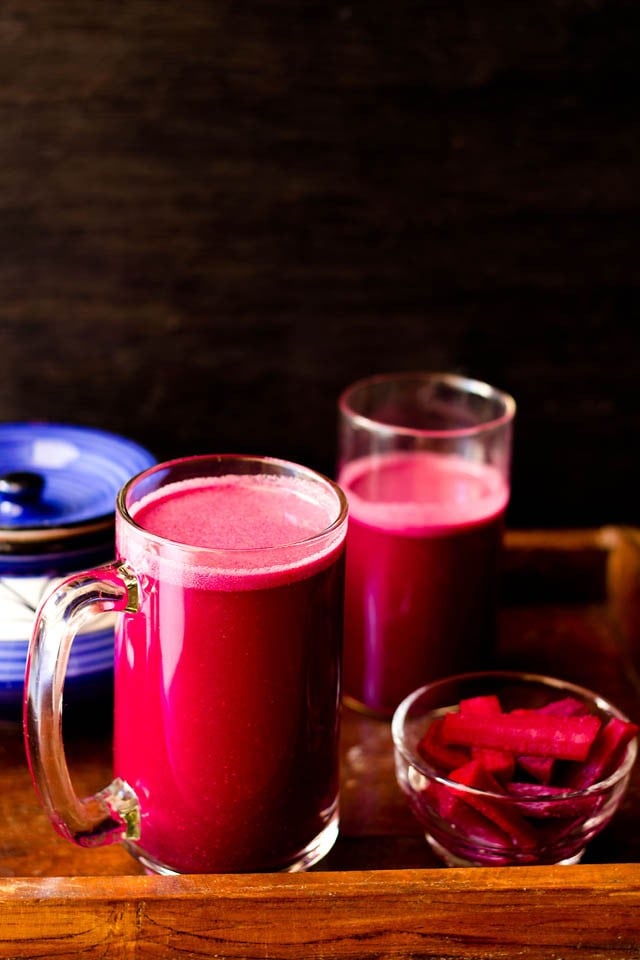
What is Kanji
Kanji is a probiotic drink made in the Northern Indian states. You can compare it with Kombucha, but the process of making kanji is entirely different than Kombucha.
Being a probiotic drink it is extremely good for the gut and improves digestion. Traditionally Kanji recipe is made with black carrots and this drink has a dark purple color. I do not get black carrots and I make this healthy drink with red carrots.
Kanji is spiced with ground mustard seeds, red chilli powder and black salt or salt. The carrots, spices, seasonings are mixed with some boiled cooled water and kept to ferment for a few days.
The entire drink with its ingredients is filled in a glass or ceramic jar. These jars are kept in the sunlight and the drink is allowed to ferment for 2 to 3 to 4 days.
It depends on how the sun is behaving in your region. So the drink can be kept for 4 to 5 days if the sunlight is not enough. If it is hot or very hot, then 1 to 2 to 3 days are enough for the drink to get naturally fermented.
The mustard in the kanji drink keeps the body warm during the cold winters of North India. The fermentation process changes the flavors of the drink and makes it probiotic. The taste is mild sweet and sour with that unique aroma of a fermented drink.
Kanji is served as an appetizer drink. It has a sour, spicy and pungent taste. This taste is an acquired one – either you will like or won’t like it, just like Kombucha.
About This Recipe
With all of you, I share my family recipe to make this healthy drink. I have learnt this method of making Kanji from my mother-in-law.
She makes this drink every year with black carrots, while I use a mix of carrots and beets to get that dark reddish-purple color – as black carrots are difficult to get where I live.
You could also make a few variations to your kanji recipe by including some turnips or peeled watermelon rinds.
While I do make kombucha almost all year around, I make kanji only during the winters. In the Indian winters, I get access to fresh tender juicy red carrots, which is not the case through out the whole year.
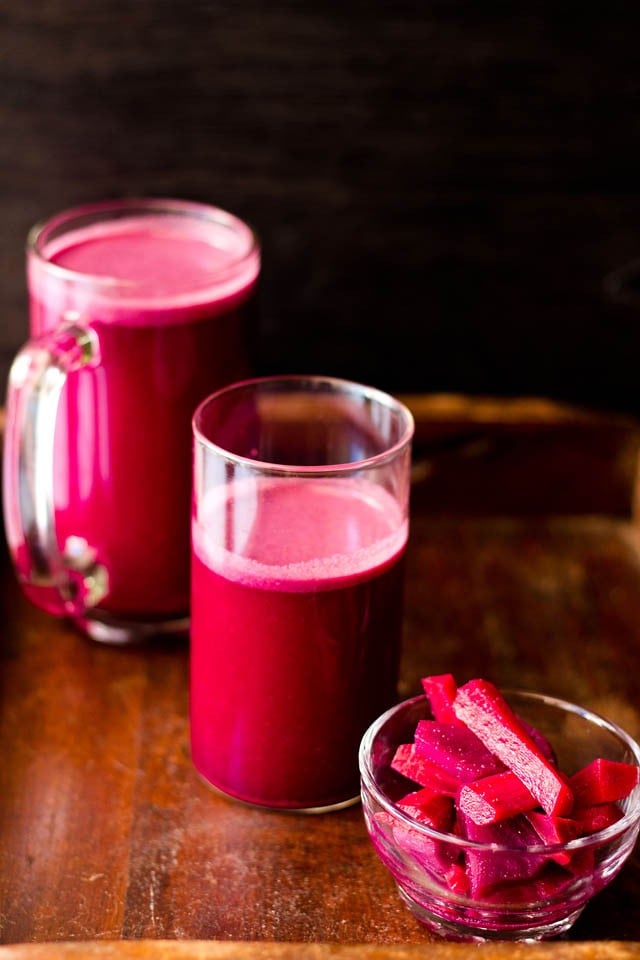
The carrots and beets get pickled during the process of fermentation. They have a lovely fermented, pickled flavor and taste. So can be served as a side condiment with any Indian main course or added to salads, wraps, burgers.
I also prepare urad dal vada (black gram fritters) to soak in the kanji. This is a variation of the popular Kanji Vada that I make.
The method of making the vada for Dahi Vada is the same as that for Kanji vada. I have given details of the vada recipe in the notes section of the recipe card below, if you would like to make them.
The soft vada soaked in the sour kanji drink tastes so good. If you like dahi vada, probably you will kanji vada as well.
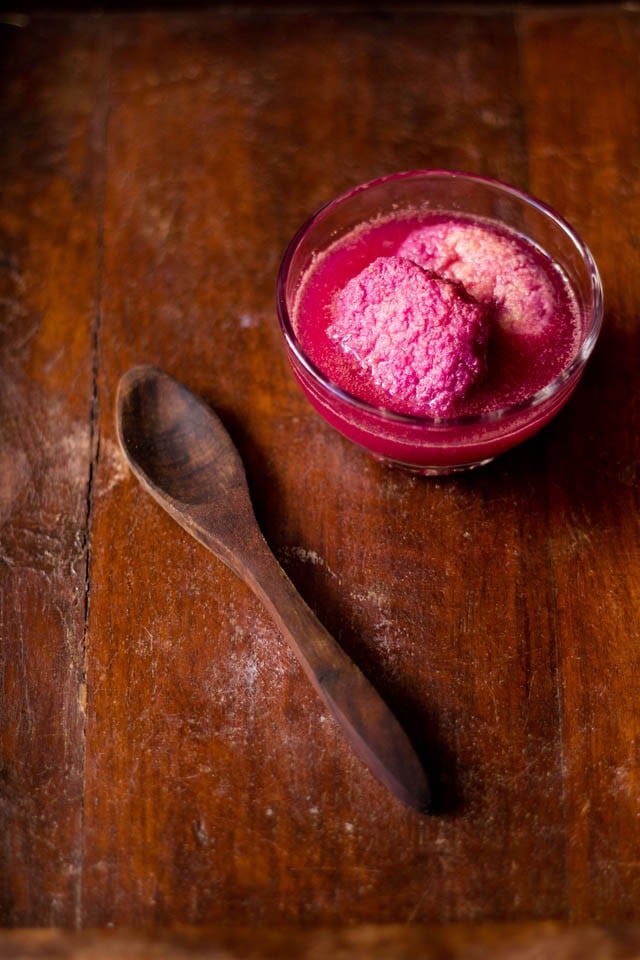
Step-by-Step Kanji Recipe
Prep The Ingredients
1: Rinse, peel and chop the carrot into batons or sticks with 1.5 to 2 inches length as shown in the photo below. Peel and chop the beets into 1.5 to 2 inches wedges or sticks.
Note that you can use orange carrots, if you do not have red carrots. If you are not a fan or beets, skip them and swap with 1 more medium-sized carrot.
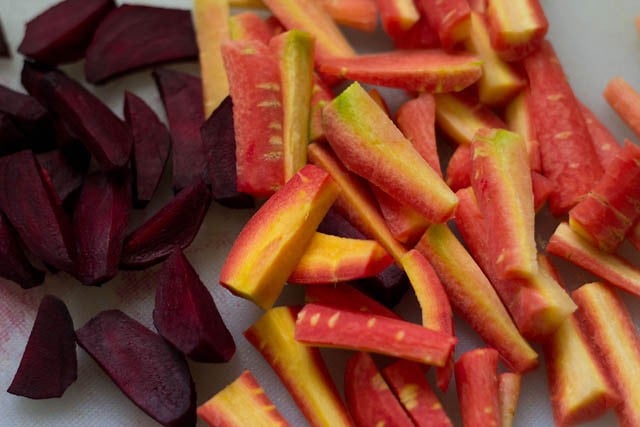
2: In a dry grinder, grind the 2 tablespoons yellow mustard to a fine powder. If including black or brown mustard, use 1 tablespoon.
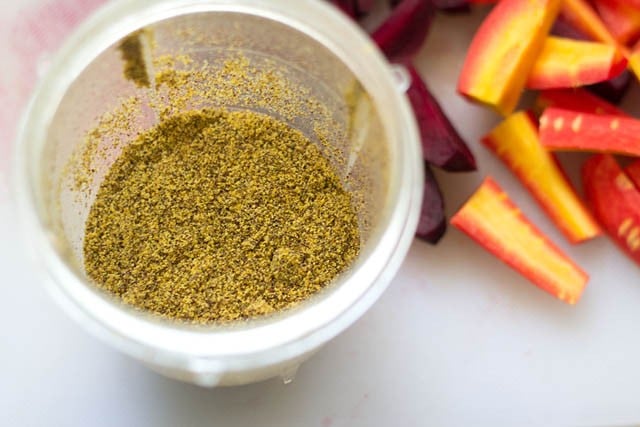
Mix the Kanji Ingredients
3: Boil water first. Let it cool at room temperature. In clean and dry ceramic or glass jar with a wide mouth, add the carrots, beets, ground yellow mustard powder, black salt or regular salt and red chili powder.
Pour this boiled cooled water in the jars. If you prefer, you can filter the water using a fine mesh strainer while pouring it in the jar.
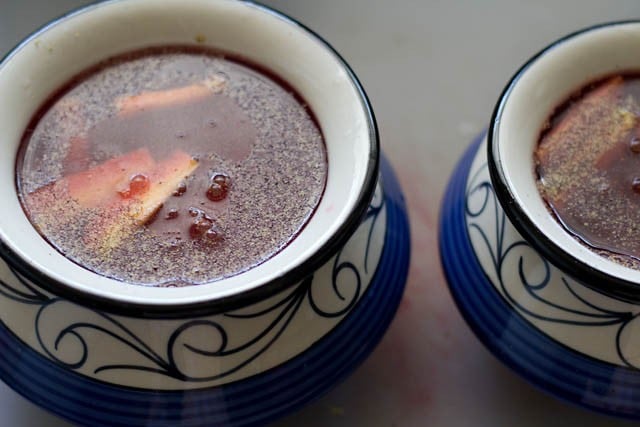
4: Stir this mixture well with a clean dry spoon.
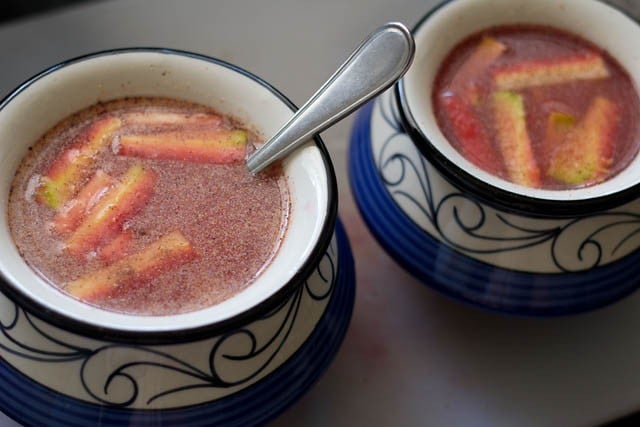
Ferment
5: Cover loosely with a lid or secure and tie a muslin/cheese cloth on the mouth of the jars or bottles. Keep the jars or bottles in sunlight.
Allow to ferment for 2 to 3 days until the drink becomes sour. Take care not to over ferment the drink.
Stir the mixture every next day with a clean wooden spoon before placing in the sun. Alternatively shake the jar instead of mixing with the spoon.
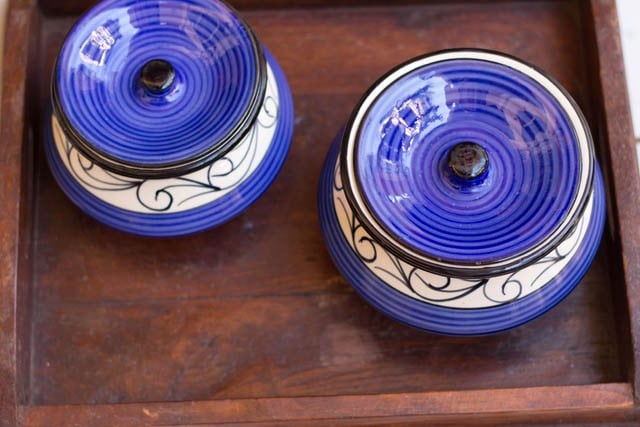
Serving & Storage Suggestions
6: When the drink starts tasting sour, it means the carrot kanji is ready. Keep the kanji drink in the refrigerator or serve straightway.
You could add a few ice cubes while serving. I like to have cold kanji, so I refrigerate it for a few hours. Kanji keeps well in the fridge for 4 to 5 days.
Drink the kanji before meals or anytime during the day. Serve the fermented carrot and beets sticks as a pickle with any Indian main course.
The sour-tangy carrots and beets can be included in a Salads or as toppings to your wraps, burgers or sandwiches.
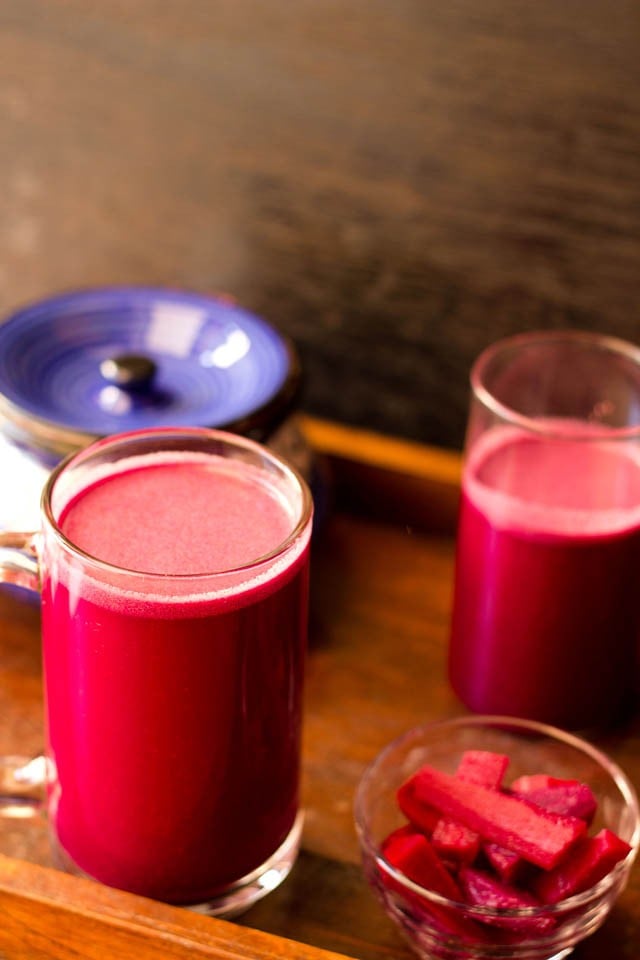
Expert Tips
- Cleanliness: Any fermented drink need care so that you do not end up with bad microbes in it. Ensure that your jars, spoons, chopping boards, knives are all clean and dry. If you see any layer of fungus, then throw away the drink. If the drink has an awful smell, that means it has gotten bad, so discard it.
- Mustard: You can choose to use both black or yellow mustard. However keep in mind that black mustard has a more pungent flavor, so add lesser amount of it – about 1 to 1.5 tablespoons. I have used yellow mustard which is milder.
- Boiling water: I highly recommend to boil water and cool it at room temperature. This way you rule out your kanji going bad. Tap water or even machine filtered water can spoil the drink.
- Variations: Together with carrots and beets, you can include turnips and peeled watermelon rinds in the drink. You do not need to add any sugar or sweetener in this drink as the natural sugar, starches in the carrots and beets help the friendly bacteria to feed on and ferment the drink naturally.
More Healthy Drinks To Try!
Beverages
Beverages
World Recipes
Please be sure to rate the recipe in the recipe card or leave a comment below if you have made it. For more vegetarian inspirations, Sign Up for my emails or follow me on Instagram, Youtube, Facebook, Pinterest or Twitter.
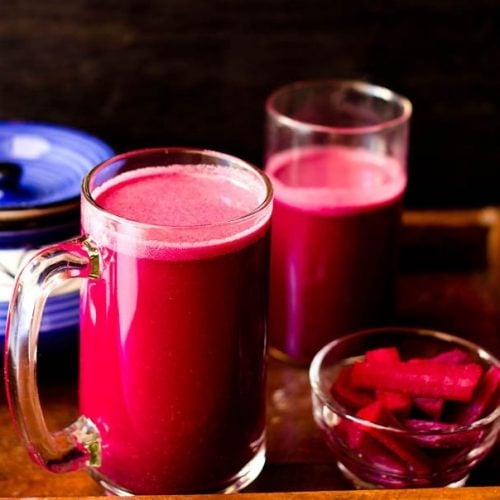
Kanji Recipe
Ingredients
- 5 to 6 carrots – medium-sized
- 2 beetroots – small-sized
- 8 cups water – approx 2 litres of water, boiled
- 2 teaspoons red chili powder or cayenne pepper – add as needed
- 2 tablespoons yellow mustard seeds or 1 tablespoon black mustard seeds
- 1 tablespoon black salt or regular salt or pink salt, add as needed
Instructions
- Rinse and then peel the carrots and beetroots.
- Note that you can use orange carrots, if you do not have red carrots. If you are not a fan or beets, skip them and swap with 1 more medium-sized carrot.
- Chop into 1.5 to 2 inches long sticks or batons.
- First boil water and let it cool at room temperature. Cover the pan when the water cools.
- In a clean ceramic or glass jars with a wide mouth, add the carrots, beets, ground yellow mustard powder, black salt, pink salt or regular salt and red chili powder or cayenne.
- Mix all the ingredients with a clean dry spoon.
- Cover with loosely with a lid or secure and tie a muslin cloth/cheese cloth on the top of the jar or bottle. Keep the jars in the sun for 2 to 3 days or up-to 4 to 5 days depending on the sunlight in your area.
- For an intense and strong sunlight, about 1 to 2 days is good enough for fermentation. When there are cloudy days and less sunlight, 4 to 5 days will work. But do ensure that your kanji drink is fermented well. Do not keep so long that will make your drink over fermented.
- Stir with a wooden spoon or shake the jar everyday.
- When the kanji tastes sour, it means the drink is fermented.
- Serve carrot kanji straightway or refrigerate. It stays good in the fridge for about 4 to 5 days.
- You could add a few ice cubes while serving or refrigerate to make it cold before serving.
- Drink the kanji before meals or anytime during the day. Serve the fermented carrot and beets sticks as a pickle condiment with any Indian main course.
- The sour-tangy carrots and beets can be included in a salad or add as toppings to your wraps, burgers or sandwiches.
Notes
To make Kanji Vada
- Soak ½ cup urad dal(husked black gram) in water overnight or for 6 to 8 hours. Drain the extra water. Rinse the soaked lentils a few times draining all the water.
- In a blender or grinder, grind the urad dal with 1 green chili, ½ tsp cumin, a pinch of asafoetida, 1 inch ginger and salt with very less water to a thick flowing batter.
- Heat oil for deep frying in a pan or kadai (wok). Gently place spoonfuls of the the batter into medium hot oil. Fry the vada until they are golden and crisp. Drain on kitchen paper towels for a few minutes
- Then soak the fried vadas in water for 12-15 minutes. Gently press the soaked vada between the palms of your hands to squeeze out the extra water.
- Soak these vadas in the kanji for a few hours or overnight in the refrigerator. Serve kanji vada cold or chilled.
Nutrition Info (Approximate Values)
Kanji recipe from the blog archives was first published on March 2013. It has been updated on December 2024.
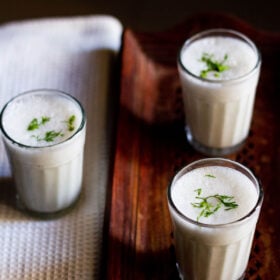
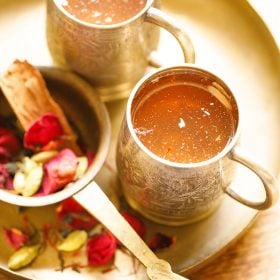
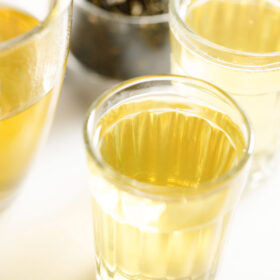
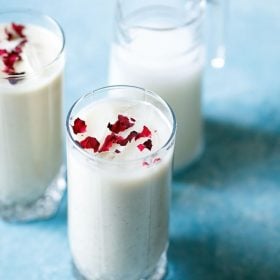
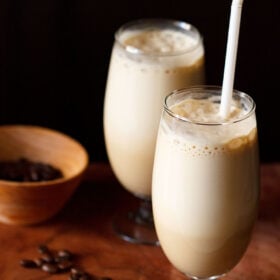
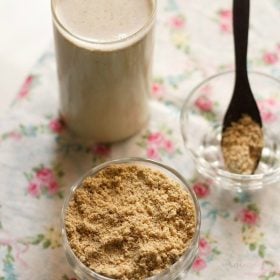
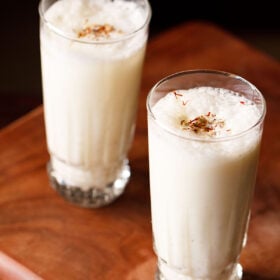
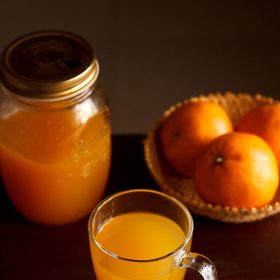








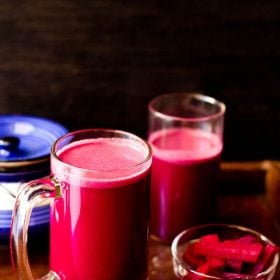
Thankyou for a detailed explanation of making storing and having. Very helpful.
Hello, I live in Canada and we don’t have sunlight for days plus it’s freezing temperature outside. What do we do in that case?
I am afraid, sunlight is needed.
Nice and simple. With detailed precautions to take for a good result.
I prepared this recipe and it turned out to be very good. Thank you for sharing.
Nice to know and thanks for sharing your feedback. Thanks for the rating too.
Awesome
Do you also have a recipe for kombucha that you make ? Please share link .
I do not have a recipe of Kombucha yet shared on the website.
Very healthy recipe, excellent
Do we need to filter the kanji before storing in fridge
no need to filter kanji.
Thanks for such an explicit recipe! My beetroots sticks have started to rotten. Is it still ok to drink the kanji?
No. Please don’t drink. Throw or trash everything.
I made this the way you stated but with black carrots. But unfortunately on opening the jar there was a whole lot of fungus on top.
What can I do to avoid the fungus happening?
a good sunlight won’t allow the fungus to appear. in which type of jar you kept like glass or ceramic. the heat from the sides of the jar is transferred to the contents inside. the top lid also as to get heated so that the heat is transferred in the jar. microorganisms like fungus cannot grow if heat is there. it is best to use ceramic jars. if using glass jars then the top can be covered with a muslin or cotton cloth. hope this helps.
Thanks for replying – I kept it in a glass jar with tissue paper on it.- there isn’t much sun here right now with winter still here – I will try keeping it covered with a muslin cloth. I think I made a mistake by not stirring it also like you said.
welcome karishma and thanks for letting me know. yes it is better to stir or shake the jar gently. a good sunlight is a must so as not to let any mould grow. but yes you can next time place a muslin cloth.
you can direct use black Carrot instead of red carrot & beetroot. i love it
yes you can. but black carrots is not easily available every where.
I made it yesterday and stored in a glass container. Sun has been quite strong here since yesterday. When stirring today evening, I found green algae kind of stuff on top. Is that normal for Kanji? Is that how it ferments? I am not sure if it’s gone off or still ok? Could anyone please advise? Thanks
Deepa, no its not normal. looks like its fungus. discard it.
Dassana
I would like to give this ti my husband who is having bacterial infection in the stomach.
But I am living qatar which s very hot now.
Could u suggest like how long I should keep this outside.
As in here the temperature is like 45,
sathya, you can keep for about 1.5 to 2 days.
Hi dassana,
Can this drink be made even during summers? Also can it be kept out in a cool dark area after the fermentation is complete?
yes ashwini, you can make kanji during summers. it is better to keep in the fridge during summers after fermentation is complete. otherwise, it will become too much fermented and can get spoiled.
I plan to make this hopefully by the end of this day. Thanks
You are welcome
Hi! I am curious to try this out, but I wonder if it is safe for pregnant women to drink it?
during pregnancy its best to avoid foods which one is not sure about. since kanji is fermented and in fermentation process, things can go wrong if the food is not handled hygienically. so i would suggest to not to have kanji drink during pregnancy. why take a risk. its better to have plain carrots or carrot salad or any dish made with carrots, which can be safely consumed.
Thank you for this post, I’m excited to try making this! I do have a question though. How much black salt should be added? Your recipe doesn’t specify.
i have not mentioned the amount of salt as the preference for salt varies from person to person. so you can add as per your taste. black salt is not salty as compared to sea salt. so you can add even a bit more. in this recipe, i would suggest adding 1/2 to 1 tbsp black salt.
Do you strain out the carrots and discard them or eat them/ use for some other purpose? Thank you for your wonderful site, have bookmarked it and return to it often 🙂
we don’t discard the carrots. we have them like a pickle with the main course.
I prepared this just now n waiting for fermentation. Now wondering if it’s safe for consumption during pregnancy. If anyone could answer this, I can drink without concerns. Thanks !!
Great!
Thanks so much for this recipe, I will definitely be making it.
Is it possible to substitute other veggies? the carrot and beet
has a lot of sugar that I would love to avoid. Also, what is a
serving size for the drink? Thank you.
welcome. usually carrots are added. i do not know of any veggie or fruit that can be added. also i have not tried making with any other vegetable or fruit. i think this proportion serves 8 to 10 glasses.
SO ECONOMICAL- I just simply love it
kali gajar -1 kg rs. 10/-
salt 5 table spoon
rai mustard powder -10/- for 100gms
water
even plastic container will do the trick
when made drink and continue to add water in the container kanji will once again form
you can do it twice
regards
agree… it can be doubled up by adding water.
pl suggest if we can use instead of mustard powder RAI SMALL MUSTARD POWDER AND PLAIN SALT INSTEAD OF KALA NAMAK AND NO MIRCHI POWDER. IMAKE IT AND IT IS SIMPLY TASTES GOOD
REGARDS
you can use small rai ka powder and plain salt too and made without mirch powder too.
I have not stored in direct sunlight for 3 days.The temprature here is around 5° to 16° and I kept it in room for 3 days it has good amount of bubbles but the taste is too much sour .
Now I kept in sunlight
Should I drink it after keeping more 2 days in sunlight
Sunlight is essential. From the beginning the kanji has to be kept in the sunlight. The reason for this is that any harmful fungi or mould will not be able to grow due to the sunlight.
If there are any hidden moulds or fungi, you won’t be able to detect or find them unless they grow so rapidly that the drink gets spoiled and has a weird smell.
I would not suggest to take the risk of consuming the drink.
Thanks. Great pictures and presentation. I have a handwritten recipe for this somewhere passed down by my mom who made tangy delish kanji. I am off to buy some carrots and makes this in Florida winter.
welcome sonum
Thank you very much. I found some black carrots in our supermarket in Canberra and thouyght of making some. Will let you knwo how it goes.
Regards
Shibu
sure 🙂
Can anyone tell me if my kanji is gone bad, as it tastes sweet, carroty sweet. This is the 4th day the jars are sitting on the kitchen counter. Last time I made it, the kanji was sour and perfect after 5 days. I just don’t want anyone getting sick. Thanks!
not sure what went wrong.
Wonderful recipe and what better thing to cool down your heat.
One thing you forgot to mention clearly in the list of ingredients is that mustard seeds must be Yellow (a. k. a. White) mustard seeds.
hi umrit. we use black mustard seeds for making kanji. hence i have not mentioned the color of mustard seeds as usually it is assumed to be black.
Hi Dassana,
last year when I made kanji did so with the white mustard seeds. It turned out fine. I thought you also used white mustard seeds now I will try with the black ones. This year winter was very harsh here but feel like making kanji now in the summer. I have been trying your other recipes as well. Thanx once again.
thanks huma. i don’t get white mustard seeds here always. difficult at times. you can make with black mustard seeds. we always make with black mustard seeds.
What do we do with the pieces of carrot & beet root? Grind it into the drink or discard?
just have the carrot and beetroot pieces like a pickle. they do get pickled and become sour. you can even have them when you are drinking the kanji.
I went to the store last night to buy carrots, beets and ground mustard. I’m starting your recipe right now and I’m excited to see how it turns out!!
do give the feedback julia.
Thank you for introducing me to such a wonderful drink. Bookmarking this.
Dassana you hit the jackpot. Kanji brought back memories. Every year in February/March we would have kanji made in our house. It is a very common drink in Lahore during this time of the year. Actually my parents are visiting here in New Jersey and I mentioned kanji to my mother. I have not seen black carrots here but my dad jumped in and mentioned the way you just wrote about as my grandfather also used your method. Again the sun problem comes here. I am still going to try it but will miss those big ceramic jars and also a “matka”. Will try in a glass jar. Thank you so much for bringing those fond memories back.
thanks a ton huma. kanji has some fond memories for me too. the entire neighborhood would be making kanji in the winter months and i would see the pots getting gently simmered in the sun. even i don’t have those large bharnis or big mason jars or matkas. i really miss having them. they are so good for making kanji as well as pickling mango or vegetables. even if you keep in day light & not direct sunlight, then too it will work. there was a day here when it was all cloudy and i still kept out the jars on the balcony. all the best and welcome.
Hi Dassana,
I made the kanji and it turned out great. I bought a tall glass jar, like we put spaghetti in. Followed the directions and it was real sunny as the temperature turned really warm in New Jersey. So my drink turned out perfect. My mother also told me that I could also add the same amount of water after taking out the kanji for drinking (do this only twice). I did that and the sourness stayed the same, although I had to add some more salt. The carrots were delicious too. Thank you for such a great delight.
thats nice huma. so the sun finally came up. the carrots and beet go very well with dal-chawal or kadhi-chawal combo.
awesome clicks.. Nice presentation and well explained.. Thanks for the recipe
I cannot wait to try this! I am so excited because fermented food/drink are so healthy! Thanks for the recipe!
welcome karen. fermented foods are healthy and kanji is also very good for the body.
Lovely colors. Right now I have been sipping another combination of carrots and fruits in kanji.
Thanks for the mention 🙂
welcome sangeeta.
Looks beautiful ….love this anytime ..fab pics
This was a love at first taste for me when I tasted this from a punjabi neighbor…The clicks look fab and I m feeling like just grabbing that glass 4m d screen
Wow, what a tempting color I love carrot and beetroot, this drink is very new to me. Love that mustard and red chilly combination. Just a quick doubt wont it be bitter dassana when we add mustard to it. This looks awesome.
hi janani. the drink is not bitter. its sour. since the ground mustard also gets fermented, there is no bitterness in the drink.
oh really thanks for the information bookmarked it dear.
Hi…I kept kaanji in the sun for 5-6 days since the temp is very low but the kaanji got fungus on top …wot should I do?
oh no. discard it. it will not be good for the body.